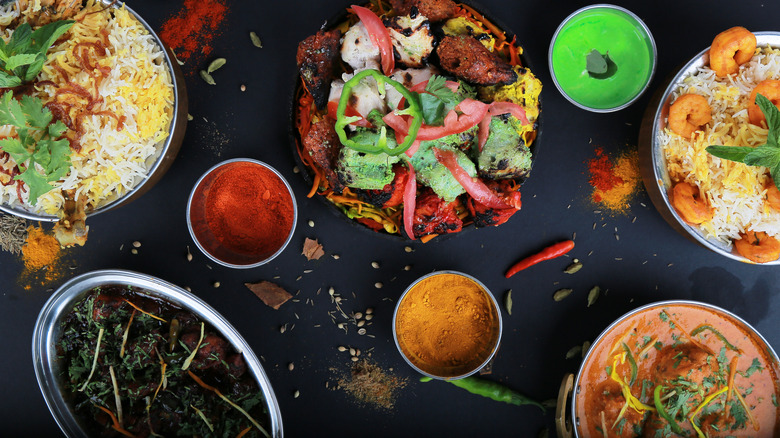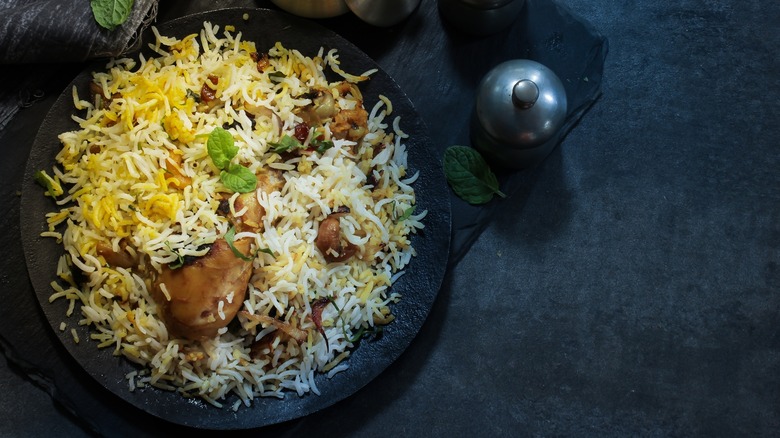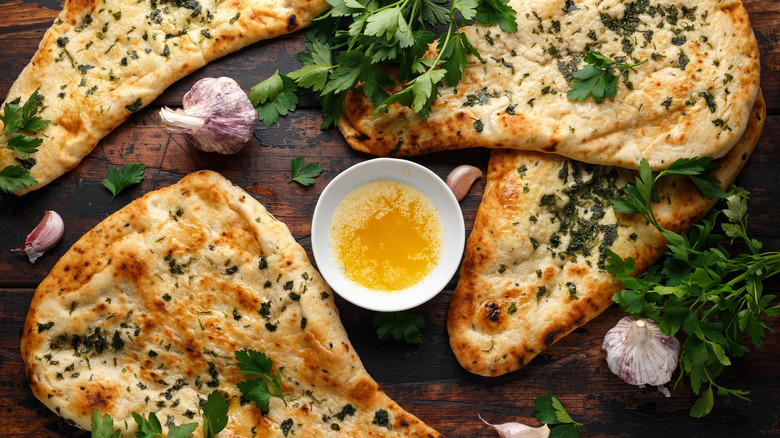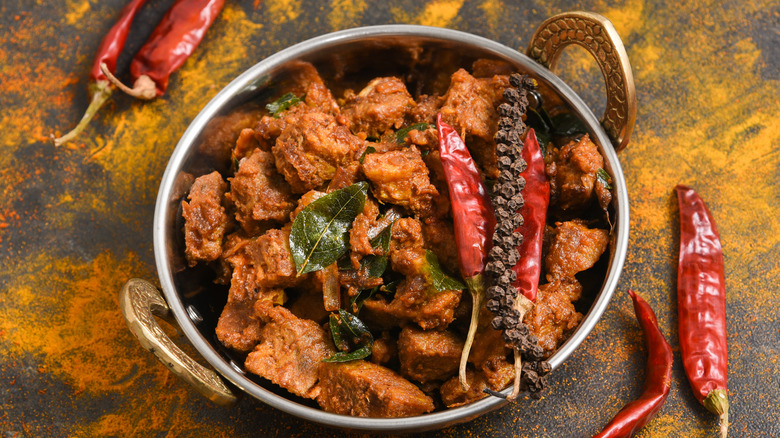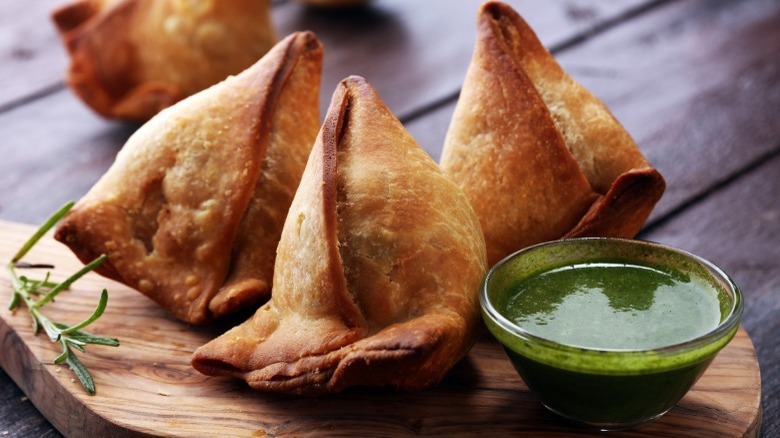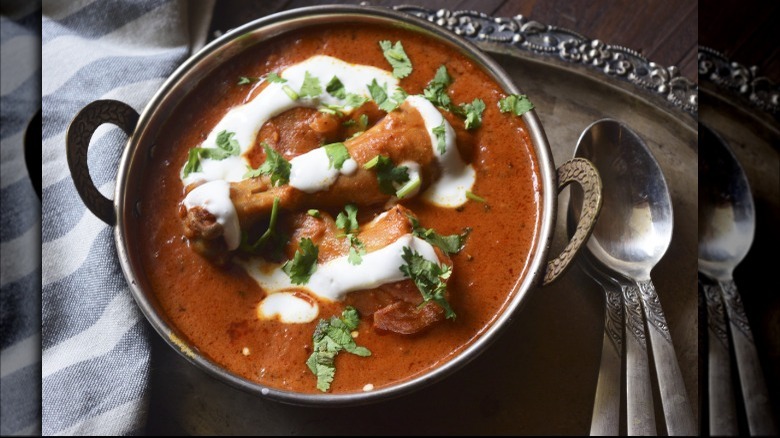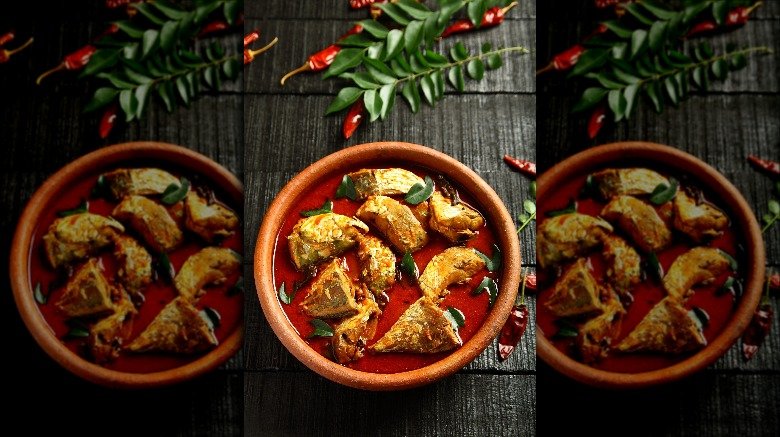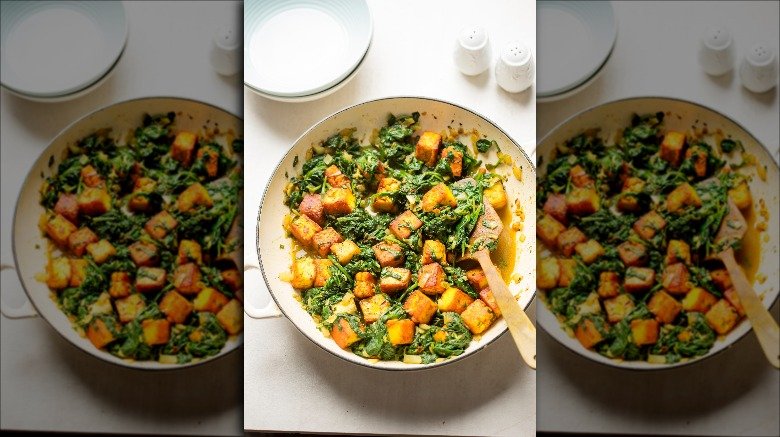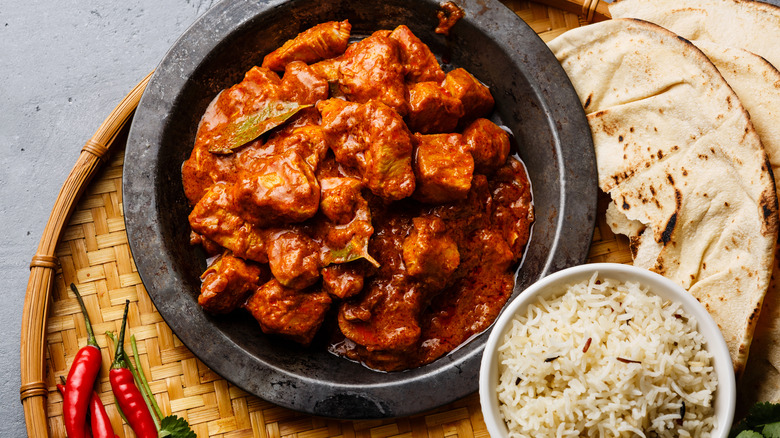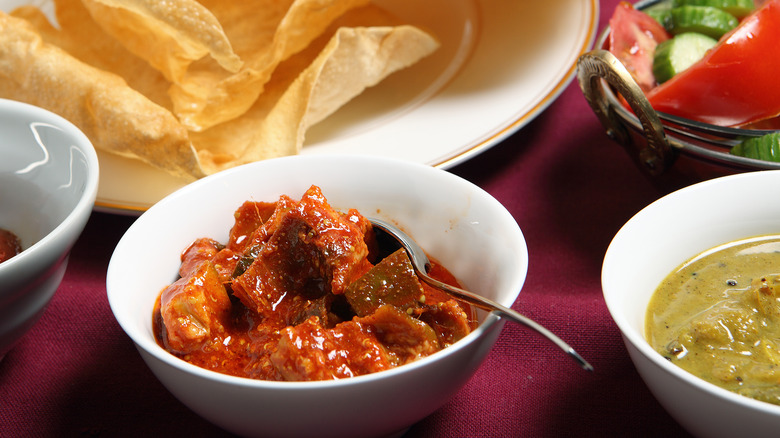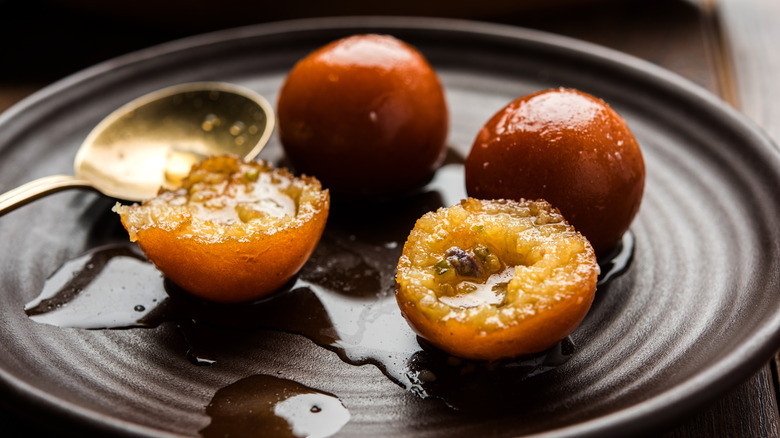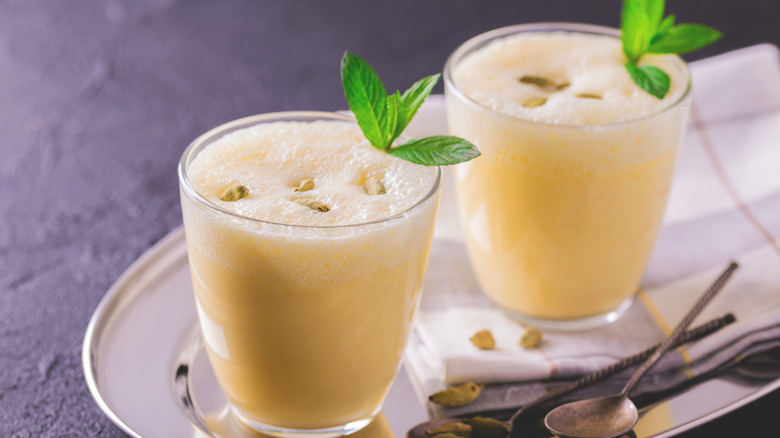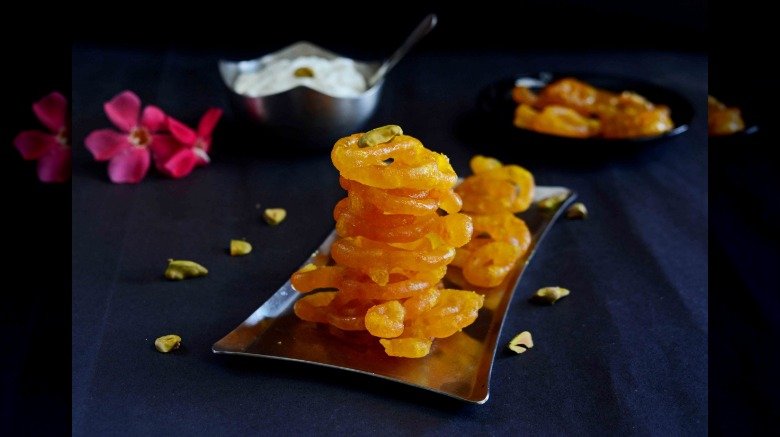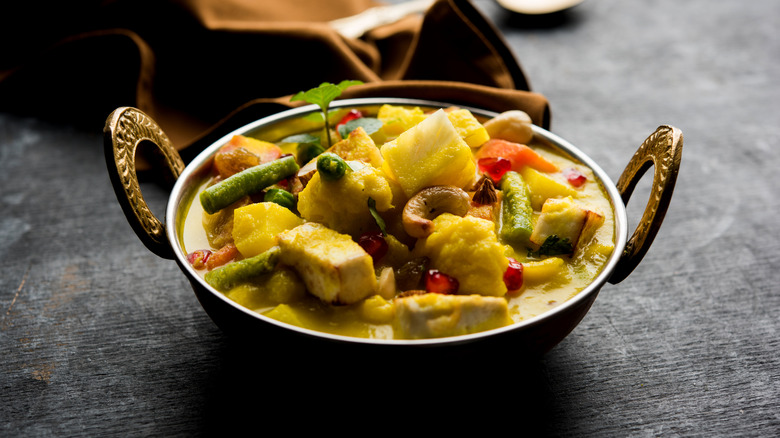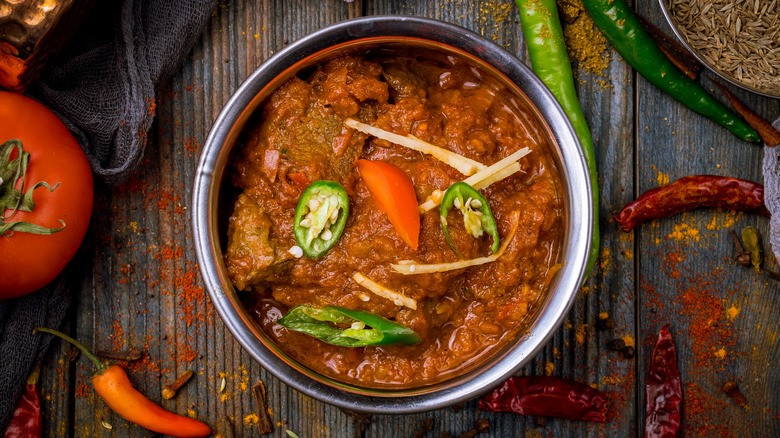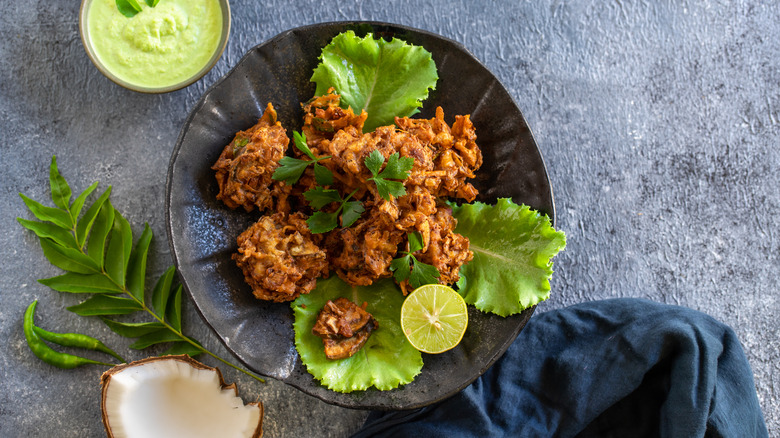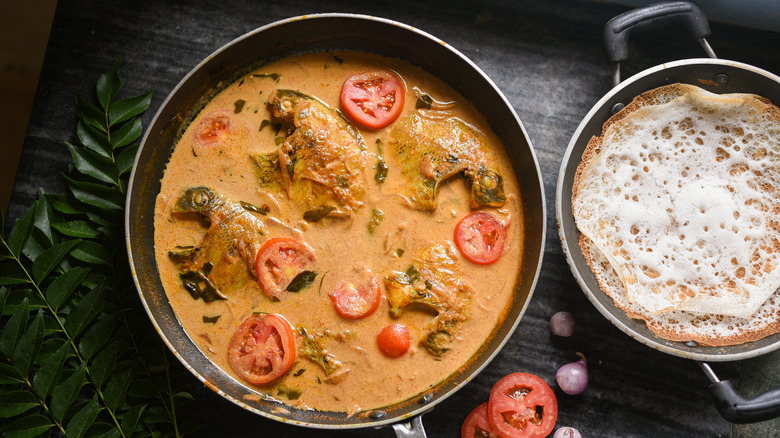What You Should Absolutely Never Order From An Indian Restaurant
Indian food is some of the most delicious food you can eat, and if you have a favorite Indian restaurant in your city, you should count yourself lucky. In the United States, there aren't a vast number of Indian restaurants to choose from.
According to the Washington Post, there are over 40,000 Chinese restaurants in the U.S., and about that many Mexican restaurants, as well. However, there are only about 5,000 Indian restaurants in America. If people don't have access to a particular food or they aren't familiar with it, they can be reluctant to give it a try, especially if the cuisine they are sampling isn't that authentic to begin with, which is an issue with Indian food in the states.
While we're happy to recommend you give your local Indian eatery a try, not everything on the menu is a good bet. Here are some typical menu items you can find at your local Indian restaurant that you definitely should not order.
Biryani should never be eaten as an Indian side dish
Let's get one thing straight, biryani is delicious. Made with rice, spices, vegetables and meat, it's also super filling. If you plan on only ordering biryani it can make a totally satisfying main dish, but if you order it as a separate course from your entree you can expect that entree to be accompanied with rice. That means two different types of rice in one meal which is a bit of an overkill.
For those of you who have never tried the delicious biryani, it can be described as a richly spiced rice dish that can be flavored with chicken, meat or vegetables. It's basically the Indian version of fried rice, and it may be ordered as either an entree or a side — this is where the trouble starts.
The calorie count of a chicken biryani made with rice, chicken, potatoes, and tomatoes clocks in at only 348 calories for a one-cup serving, but if you plan on ordering an additional entree, you should probably think about picking one or the other. It would be too tempting to eat both the biryani and your entree, depending on how hungry you are, and nobody needs that much rice in their life.
Skip the garlic naan at your favorite Indian spot
A really good garlic naan bread is one of the yummiest things in the entire world, but you still shouldn't order it to accompany your meal because it contains 385 calories and 65 carbs for one piece. You are better off getting plain naan bread which has only 260 calories and 42 grams of carbs, and is just as filling.
Sure, sopping up curry sauce with garlic naan makes it extra delicious, but using plain naan just as good of a job at cutting the heat factor of some of the spicier Indian dishes. Plus, garlic naan has too many calories to make it worthwhile. Delicious, fluffy, buttery, garlicky calories, but calories none the less.
Do yourself (and your daily calorie count) a favor and opt for the plain stuff. We promise it's still delicious — especially when you've used it to clean up those leftover saucy bits on your plate.
Pass on the vindaloo, unless you're a badass
Vindaloo is known as the spiciest dish at Indian restaurants and those with a low tolerance for heat should steer clear. Americanized vindaloo is usually made with meat, vinegar, potatoes and chili peppers, which is where the aforementioned spice level comes into play. Traditional Goan vindaloos contain cardamom and cinnamon and aren't nearly as spicy. Another factor to consider is where you are ordering vindaloo from, because every chef will have their own preferences as to what the spice level is.
However, it is universally agreed that it can be pretty darn hot. It is extremely delicious, especially if you enjoy spicy food — but it's the kind of menu item to steer clear of unless you plan on drinking all the table's water, everyone's gin and tonics, and any and all leftover wine your dining companions have in their glasses... plus the water from the vase your table's flowers are in.
You don't need an Indian appetizer like samosas
Samosas are basically deep fried dumplings filled with deliciously fatty mashed potatoes, meat, and the occasional vegetable. Exactly the sort of mouth-watering calorie bombs that taste wonderful, but add a whole mess of fat, carbs and little nutritional value to your meal.
The amount of calories in one samosa simply filled with potatoes and peas is 308 calories... that's just for one. It's roughly the size of a wonton and all it's going to make you want to do is have another samosa. Pair that with a delicious dipping sauce like the traditional accompaniment of mint chutney, tamarind dipping sauce, or raita, and you can pretty much kiss your calorie allotment for lunch or dinner goodbye, because these delectable little babies are usually served as an appetizer.
If mango chutney is served alongside these, you can plan on eating roughly 20 or so before the rice even hits the table. Okay, maybe not 20, but enough that when you fall asleep at night all you'll be dreaming about is the next time you can eat a whole mess of samosas.
Don't order butter chicken the next time you eat Indian food
Have there ever been two more delectable sounding words that go together like butter and chicken? It's almost as delicious as peanut butter and chocolate, but peanut butter and chocolate don't taste nearly as delicious with rice and a nice dry chardonnay.
Butter chicken is usually a mild dish, with boneless chicken simmered in an almost-sweet curry sauce and finished with, well, butter. It's the ideal meal to order for your adolescent dining companion so you can steal some off their plate. The only issue is that if you order this yumminess for yourself, and even if you somehow only consume one measly cup of it (a feat that's nearly impossible), you are still looking at around 485 calories and 35 grams of fat — and that's if you don't have it over rice (which, by the way, is our preferred way to eat it). Ouch.
Stay away from those Indian curries
It sounds like common sense but it needs to be said: If you are prone to heartburn, you should steer clear of curries. Curries contain onions, tomatoes and garlic, all of which are highly acidic, and could easily lead to bad case of heartburn. According to Livestrong, eating curry can have other unpleasant digestive issues as well, such as stomach upset, nausea, dizziness, or diarrhea due to the turmeric used in curry powder. While that Indian curry may be delicious, and you think it's we'll worth the pain it causes on the way down, you may think twice when confronted with the other, eventual consequences.
Many Indian restaurants have candied fennel seeds at the checkout register and fennel has been known to be a natural heartburn remedy, so if you suffer from that gastronomical distress you'd be smart to grab a handful on your way out.
Saag paneer may be vegetarian Indian food, but it's still not healthy
Saag paneer is an Indian vegetarian dish made with leafy greens like spinach mixed with deep fried cheese, garlic, and cream. If you stopped at spinach you would be totally fine, but it's all the yumminess of the deep frying and cream that take this dish over the top into a carb and calorie-heavy wonderland.
One cup of traditional saag paneer usually contains roughly 270 calories and 27 grams of carbs. Even though this dish is rich in calcium and has spinach which contains vitamin K and folate, there are healthier vegetarian options available at your local Indian restaurant. Healthy Eating suggests swapping out your saag paneer for matar pulao, which contains only 9 grams of fat and 15 grams of carbs, due to not having any cheese or cream.
Another healthy vegetarian option is aloo gobi, which contains cauliflower, potatoes, ginger and chili peppers. Just make sure it's prepared as a stir fry rather than deep frying the cauliflower — nothing deep fried is ever a healthy choice.
Chicken tikka masala might not even really be Indian food
Chicken tikka masala looks a lot like butter chicken, and it's basically just as delicious and as unhealthy. Not only is chicken tikka masala prepared with some type of cream, but often it has the addition of coconut milk as well. This isn't always the case — one survey found that of 48 different chicken tikka masala recipes, the only common denominator to every one was chicken. Basically, you never know what you're going to get with this dish, but an average portion has a staggering 1,249 calories and 90.8 grams of fat.
Not only are most recipes for this super popular dish different from one another, but there's also the question of where exactly the dish originated from. Some trace its origins to Bangladesh migrant chefs in Britain in the 1960s, while a restaurant in Glasgow takes credit for its invention when they had a customer who complained his chicken was too dry. The owner of the restaurant, Ali Ahmed Aslam, took the meat back to the kitchen where he mixed it up with some tomato soup and various spices and thus chicken tikka masala was, supposedly, invented. Regardless of where exactly this dish came from, it probably wasn't India, so skip this dish if you're looking for authentic Indian food.
Poppadom is an Indian appetizer that's hard to quit
Poppadom are delicious little Indian cracker-type chips, usually made with lentil flour, or chickpeas, potatoes, or rice. They can be deep-fried or roasted (though they're usually deep fried when served in the United States), resulting in a yummy Indian appetizer or even main dish. While some prefer to eat them plain, they're usually served alongside chutney, dip, vegetables, or even cheese.
A single poppadom contains about 65 calories, which isn't bad by itself — that is if you can make yourself stop at just one, which is pretty hard to do considering how delicious they are. When you factor in the toppings (and the fact that you're likely to down a whole plate before your entree even arrives), you'll understand why it's a good idea to just say no to this innocent looking Indian meal opener. Can you eat just one tortilla chip while waiting for your dinner at a Mexican restaurant? If you said no, you won't be able to do it here, either.
Gulab jamun are basically Indian donuts, so skip them
This Indian dessert is made from milk solids which are then turned into a soft dough and deep-fried. Imagine a super delicious doughnut swimming in a sugary syrup made from rose water, and the gulab jamun is basically Krispy Kreme's sexy bad-girl cousin. The issue with these little balls of delight are they are 143 calories and 17 grams of carbs just for one measly doughnut. Even though gulab jamun shows up on many an Indian dessert menus, they are traditionally reserved for special occasions like holidays and weddings.
If the calorie doesn't concern you, consider the fact that sweet "Indian" treat isn't even Indian at all. It may be a dish that is served in India today, but it was born in Persia and later brought to India. Skip this fat-laden dessert and go with something a little more authentic (and maybe a little healthier) instead.
Mango lassi is the wrong way to cool down from all that Indian spice
We all know we aren't supposed to drink our calories, but when confronted with a mainstay of Indian menus such as a mango lassi, it's hard to remember that nutritional golden rule. Made with fresh mango, cardamom and yogurt, it's a delicious addition to a spicy meal. But it's basically like drinking a milkshake, just with the nutritional value of mango and the calcium from yogurt. A delicious milkshake, but still a milkshake. At nearly 200 calories for a one cup serving, you are better off ordering a glass of wine to enjoy with your meal instead, which only contains 120 calories at minimum. or even better, wash it all down with a big glass of water, and don't worry about drinking those calories at all — it just leaves room for more food, right?
Jalebi is about as bad as it gets for Indian food
Congratulations jalebi! This delectable Indian dish made it onto one list of ten of the most fattening foods in the world due to the fact it's basically a funnel cake soaked in saffron syrup. The calorie count on these babies is pretty staggering, with 310 calories and 54 grams of carbs for just one piece! Move over gulab juman, these jalebis are even more unhealthy.
When dining out, it's difficult to make smart choices, especially when Indian cuisine has so many delicious choices that are made with cream and ghee. Tandoori items are usually a safe choice, due to the fact they are simply covered in yogurt and spices and baked in a tandoori oven. Plus, any time you can order a side of vegetables without additional sauces or butter is a nutritional win. Maybe even a big enough win where you can enjoy a few bites of a jalebi after dinner, or a sip or two of mango lassi.
Navratan korma isn't as healthy as it seems
At first glance, navratan korma seems like a healthy option. It's usually vegan or vegetarian, although sometimes you can find it with chicken. It's a sweet curry, so if you're looking for a mild flavor profile without too much heat, it checks that box. Navratan korma means "nine-gem curry" and was named for the advisors of Akbar the Great, a ruler in 16th century India (via Britannica). It's made with a nine-ingredient combo of vegetables, fruit, nuts, and sometimes paneer, a soft cheese.
The problem comes with the way restaurants make food delicious by using hearty helpings of salt and fat, not to mention tremendous portions. In the case of navratan korma, that means using heavy ingredients to make the sauce, such as coconut cream or heavy cream. Korma is part of Mughlai cuisine, which is known for being creamy, silky, and decadent, as per "Izzat Ka Khana." This translates to plenty of calories from fat. Ordering dal or sambar instead will please your taste buds and your waistline.
If you love navratan korma or want to try it, it's pretty easy to make at home, which lets you use healthier ingredients. While not as indulgent as coconut cream, Healthline notes that coconut milk will cut down on fat and calories while still contributing serious flavor.
Lamb rogan josh is simple to make at home
Lamb rogan josh is a delicious stew usually served with basmati rice or naan. In moderation, lamb is a terrific addition to a healthy diet, providing 23 grams of protein and plenty of nutrients (via WebMD). Of course, like many foods, eating huge portions of lamb isn't as good for you. As per the journal Obesity, a survey of chefs showed that portions in restaurants are as much as four times larger than recommended serving sizes. That's a lot of meat.
Restaurants are known for adding extra salt and fat to dishes because it makes them taste better, and combined with skimping on veggies, this could spell diet disaster (via Rand Corporation). If the chef doesn't trim the lamb (leaving the fat lends richness to the stew and speeds up prep), that restaurant portion could be an enormous calorie bomb.
Thankfully, it's easy to make lamb rogan josh at home. Stews are easy beginner recipes, and by trimming the lamb of visible fat, substituting yogurt for cream, using less oil or ghee, and giving vegetables a starring role, it's easy to make this fabulous traditional curry part of a healthy diet.
Pakoras are too irresistible
Everyone falls into one of two camps when dining out: those that always order appetizers and those that consider them excessive. Unfortunately, deep-fried appetizers are a quick way to eat hundreds or even thousands of calories before your entree ever reaches you.
Pakoras, made from combinations of veggies, cheese, or chicken coated in a batter made from gram flour (also known as chickpea flour) and deep-fried to perfection, are one such stumbling block. According to Calorie King, each pakora has approximately 300 calories and 22 grams of fat. Let's say that most of us would eat way more than one and leave it at that. If you want a lighter appetizer, order roti, which is similar to naan but is made with whole grains, or a grilled appetizer like bhara kabobs, spicy vegetable patties served with mint chutney.
If you love pakoras and can't imagine life without them (we agree!), they're simple to make in your kitchen. Improve the health factor of these treats by baking or air frying them instead of traditional frying. Bake or air fry till golden, and you'll have light and healthy pakoras instead of a caloric catastrophe.
Make fish molee at home
Molee is a fish stew from Kerala, a coastal state known for its fishing industry (via Britannica). Recipes vary, but it's always a thin, creamy stew spiced with chili, garlic, ginger, turmeric, and curry leaves. It might contain haddock or cod, monkfish or tilapia, and occasionally prawns. Molee isn't a veggie-packed stew, as it typically only has tomatoes and onions. It's traditionally served over rice or with appam, a soft pancake-style bread (via TasteAtlas).
As with many dishes on this list, ordering molee at a restaurant is the real problem. While many recipes for molee call for coconut milk, chefs are in the business of delicious food, which means plenty of fat courtesy of coconut cream, which helps to create an extravagant texture and taste. Unfortunately, Healthline reports that coconut cream gets most of its calories from saturated fat, which increases the risk of heart disease, weight gain, and high cholesterol.
Fortunately, making a lighter molee at home is quick and easy. Sautée onions with the curry spices, add the coconut milk, bring it to a simmer, then add the fish and tomatoes, cooking for only a few minutes until the fish is done. There are many substitutes for coconut cream, too, depending on your preferences and dietary needs. Choose your favorite and enjoy a healthy alternative to restaurant molee.
